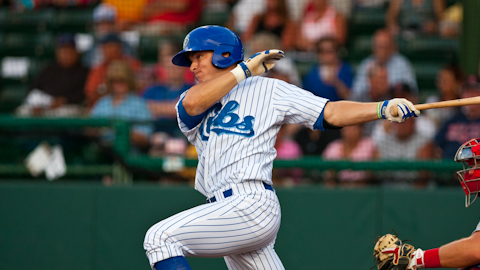Player Interview with Cubs Outfield Prospect: John Andreoli
Today’s player interview features Cubs outfield prospect, John Andreoli. John is a native of Massachusetts and attended college at the University of Connecticut. He was drafted in the 17th round by the Cubs and has spent two seasons playing in their system. John was selected as a Florida State League Post-Season All-Star in just his second year while playing for the Daytona Cubs.
John comes from a family full of athletes and coaches. His intellect as a player has allowed him to be successful in baseball. In working at Cressey Performance, I have had the opportunity to meet John and discuss baseball on a daily basis. These conversations culminated to this; an official interview where John has answered questions about hitting and making the transition from college to professional baseball. Regardless of the level of baseball, this insight from John is beneficial for all of those whom play the game.
Q: Mechanically speaking, do you have a linear, rotational, or extension based approach to hitting?
John: When looking at my swing mechanics, I believe that I have a linear, rotational, and extensional approach to hitting. As hitters we learn from a very young age that you have to stay on top of the ball. From a mental standpoint this is a necessity. What I have come to learn over the past year is that in the high intensity of a game, our body naturally over emphasizes our actions. If a hitter does not concentrate on staying on top, the high pressure of the moment will cause a long and upper cutting bat path.
Alongside linear, a good swing from any hitter involves both rotation and extension. When a hitter drives the baseball, he gets into his front side with his lower half. This process of weight transfer from the backside through the front side is where the swing is rotational. Once contact is made, the swing becomes an extensional approach. The longer a hitter can stay on the plane of the ball with a top hand/ bottom hand position, the more success he is going to have. Once a hitter loses this top hand/ bottom hand feel, his chances of creating backspin on the baseball greatly decrease.
Q: What changes did you make mechanically when transitioning between college and professional baseball?
John: As I transitioned from the college to professional level, there were two main adjustments that I have had to make. The first is to change my mental approach in the batter’s box. In facing better competition in every level one progresses, the mental approach to an at-bat becomes that much more important. I had to realize the type of hitter I am (middle of the field), and what type of pitches bring me the most success.
Drill: Whether it is in front toss of BP, cut the plate in half (Middle in/Middle Out). Take turns of strictly looking for a pitch in one of the two zones – taking the pitch if it is in the zone you are not looking for. This works on developing an approach and hitting pitches we have prepared ourselves to hit.
Secondly I had to slow the process (from start to finish) of my swing down. In my high school and college years, the metal bat helped me get away with a lot. I was a very herky-jerky, tight, full effort hitter who found myself going to get a lot of pitches instead of letting it come to me. The process of slowing down a hitter’s swing is one in which 99% of big leaguers have mastered. Every swing has its different timing (leg kick, no stride, toe tap), but all good hitters get their foot down and are in the hitting position at the same point. One of the keys that have worked for me is to concentrate on getting my foot down when the pitcher gets his foot down. Obviously if a hitter gets his foot down too late, he is going to get beat, but if he gets his foot down too early he creates a start-stop motion which results in no rhythm and less bat speed.
Drill: Swing with a heavy bat for a good portion of your off season training. These bats are usually around 35-38 oz and will force a hitter to slow down his swing, taking away the ability to “muscle” the bat.
Q: Do pitchers attack hitters differently in professional baseball versus college baseball?
John: I believe that pitchers from professional and college baseball attack hitters the same. Depending on the type of pitcher, some pitchers will try to establish the inside part of the plate. Others will work to build the zone off of the outside corner. In both of these situations a hitter just has to lock in on the pitcher’s command for each pitch on that given day, and adjust his approach according to what we will see. For example, if we are facing a sinkerball pitcher who is trying to throw fastballs on the inner half, we have to adjust. In this scenario we want to see the ball up in the zone (lower strikes will drive into the dirt) and take Zones 1 and 2 out of our hitters zone (These pitches will naturally run off the plate)
By Zones 1 and 2, imagine the plate being broken down into 6 Zones of hitting
Inside Black – Zone 1 – Zone 2 – Zone 3 Line down the Middle – Zone 4 – Zone 5 – Zone 6 – Outside Black
*Note* This would be the opposite for a lefty
Q: Speaking in terms of approach at the plate, when does your preparation for the at-bat start?
John: I believe that the preparation for an at-bat starts as soon as you get to the ballpark. In most situations you have scouting reports on what type of pitcher is throwing that given day. In knowing how he pitches right/left hitters, we can start to go through our routine in preparation for what we will be seeing that day.
In a scenario where you have no scouting report on the pitcher throwing, I like to get out on the field early and see what kind of stuff he has. I believe you can tell what kind of mentality a pitcher has from how he approaches his warm up. If the bullpen is visible, a hitter can see what type of pitches he throws, where his arm slot is, and how quick/long his motion is out of the stretch. In addition, a hitter should use his teammates at-bats as a personal scouting report. What does he like throwing to right handed hitters (I’m right-handed)? What is his out pitch? Does he fall into a similar pattern in certain counts? Does he lead at-bats with the same pitch? Is he missing spots? Is he working inside/outside?
Q: Describe your thought process in a hitter’s count (3-1, 2-0) compared to a two-strike count.
John: When I am in a hitter’s count, I am looking for one pitch in one spot. The main thing here is to not be over anxious in these counts. Especially when it is 3-1, you see many hitters become too aggressive and go out of their zone. Hitters need to take their walks. When they don’t hitters end up miss hitting a lot of pitches and get themselves out. The key here is to know what pitch you want to hit, to put a good swing on it when you get it, and not be afraid to take a pitch. In both scenarios, a hitter can take a strike and still be in a hitters count (2-1 hitters count, 3-2 hitters count – pitcher needs to throw a strike). In knowing this, a hitter needs to let a pitcher come to him and make sure the pitcher pays when we get what we want.
The two-strike approach is completely different than the 3-1, 2-0 approach. When a hitter has two-strikes, he has to go into battle mode. First thing is that he MUST look fastball. If a hitter falls into the assumption that he may see a 1-2 curveball, that is all he is going to be able to hit. When we look fastball and adjust off-speed, we as hitters have the ability to hit any pitch. Also we have to look fastball middle away. Our fastest reaction as hitters will be to a fastball inside, and therefore we must use this as protection. Most pitchers are going to throw sliders/curves that work as chase pitches away from hitters. In looking middle away, our eyes will recognize these pitches easier and will increase our chances of fighting them off or putting them into play.
Drill: Front toss or BP two strike round. Take this same battle approach (looking middle away) and learn to recognize and fight off pitches. If it is a debatable strike, we should fight it off and not leave it up to the umpire.
Q: When working in the off-season, what does a typical cage session look like for Jon Andreoli?
Tee Work
2 Rounds of 10-15 Warm-up off tee – 60%
2 Rounds of 5-5-5 Outside/Inside/Middle
1 Round of 6-8 Low tee
Add. Drills: Two Tee Drill, Top/Bottom Hand w/Short Bat, Step Back Drill, High Tee Drill, Hitting off a tee w Fungo (Extension)
Work in these drills after Low Tee – Usually 1-2 a Day
Front Toss
Rounds of 8-10
2 Rounds of Top Hand Drill w/Short Bat
1 Round of Bottom Hand Drill w/Short bat
Add. 1 Round of Top Hand Drill w/Short ball
2 Rounds of 5-5-5 Outside/Inside/Middle w/Reg bat
Add. Drills: Heavy Bat, Step Back Drill, Swing with Fungo, Offset Drill
Batting Practice
6 Rounds of 5
1 – 2 Bunt for Hits, 2 Sac, Squeeze
2 – Middle Round
3 – Hit-Run, 2 Get the Runner over, 1 Get the Runner in (Infield In), 1 Get the Running in (Infield back)
4 – Two Strike or Middle-Opposite Field Round
5 – Zone Round (3-1, 2-0 Approach)
6 – Middle Round
Q: Finally, how has your off-season at Cressey Performance helped to enhance your successes as a hitter?
John: If you are serious about baseball and want to reach your potential and more, Cressey Performance is where you want to be during the off-season. In going through my first full season of 140 games plus spring training, I felt that CP prepared my body for the grind. It helped me become more explosive both when hitting and running, it gave me flexibility that kept me healthy throughout the long haul of a season, it helped me develop a quicker first step towards fly balls and when stealing bases, and it built up muscle mass for me to rely on when the hot days of July and August came.
I credit a great deal of my success as a professional baseball player to the staff at Cressey Performance, and wish I had done it early in my baseball career. No matter what age you are, CP creates programs structured for the individual athlete, and works to develop one’s weaknesses into strengths.




One comment